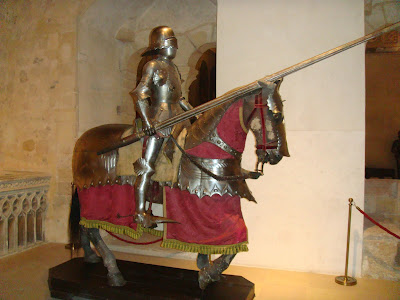Aqueduct
This is probably the most recognized and famous symbol of Segovia. It was built by the Romans (and contains the arches for which they are so famous) approximately 2,000 years ago.
 In total, the aqueduct extends for 20 miles and connects to a nearby spring.
In total, the aqueduct extends for 20 miles and connects to a nearby spring. And at its highest part stands 100 feet tall. All together, there are 167 arches (from what I read...I didn´t count).
And at its highest part stands 100 feet tall. All together, there are 167 arches (from what I read...I didn´t count). After climbing a lot of stairs, this is the view of the city from a ledge near the top of the aqueduct.
After climbing a lot of stairs, this is the view of the city from a ledge near the top of the aqueduct.
Cathedral
A little further into town is the cathedral. Located in the Plaza Mayor, it was constructed in the early 1500s and is considered to be Europe's last great Gothic cathedral. It was ordered to be built by the king after the town's original cathedral was destroyed a local mob, apparently in a revolt against the same king.
 As is typical with Spanish cathedrals, the ceilings are enormously tall and every spare piece of space (walls, columns, ceilings, etc) are intricately decorated.
As is typical with Spanish cathedrals, the ceilings are enormously tall and every spare piece of space (walls, columns, ceilings, etc) are intricately decorated. This is one of the main altars on the inside.
This is one of the main altars on the inside.
Alcázar
It is believed to have been built in the early 1100s as an Arab fort, but it was gradually expanded once the city was conquered by the Christians. Throughout the Middle Ages it remained one of the favorite residences of the Monarchs and a key fortress for the region.
It is located at the complete edge of town on a cliff's edge overlooking the valley below. And by having such as location, one can only enter through the small front entrance or attempt to scale the cliffs.
Although the Alcázar was originally built as a fortress but has served as a royal palace, a state prison, a Royal Artillery College and a military academy since then.

 And a close up of the turrets.
And a close up of the turrets. Of course no castle would be complete without an armory, and no armory would be complete without a full-fledged horseback knight.
Of course no castle would be complete without an armory, and no armory would be complete without a full-fledged horseback knight.I tried challenging him to a duel, but he ignored me.
 There were all kinds of rooms on the inside including a chapel, living quarters, waiting rooms, dining rooms, etc. My favorite was the "Hall of Monarchs" which included porcelain replicas of various kings seated around the entire room. You can see them below the ceiling.
There were all kinds of rooms on the inside including a chapel, living quarters, waiting rooms, dining rooms, etc. My favorite was the "Hall of Monarchs" which included porcelain replicas of various kings seated around the entire room. You can see them below the ceiling. As mentioned, the building at one point housed an artillery school. They had an entire wing with early teaching materials, much of which was engineering-related. This picture for instance should look instantly recognizable for anyone who has taken intro Physics ("a cannon shoots a ball at x angle and x velocity...where does it land and what is its angle of impact"?)
As mentioned, the building at one point housed an artillery school. They had an entire wing with early teaching materials, much of which was engineering-related. This picture for instance should look instantly recognizable for anyone who has taken intro Physics ("a cannon shoots a ball at x angle and x velocity...where does it land and what is its angle of impact"?) After that, the only part of the castle left was the tower, with a sole small spiral staircase in and out. It was actually quite tricky to have one person coming up with another going down; lets just say we had to get friendly.
After that, the only part of the castle left was the tower, with a sole small spiral staircase in and out. It was actually quite tricky to have one person coming up with another going down; lets just say we had to get friendly. Fortunately the view was well worth the awkward rubbing with strangers. As a point of reference, the cathedral is the tall structure on the left-hand side.
Fortunately the view was well worth the awkward rubbing with strangers. As a point of reference, the cathedral is the tall structure on the left-hand side. And this is the view of the valley which surrounds the Alcázar.
And this is the view of the valley which surrounds the Alcázar. 
This was taken after exiting the building and a few minutes walk away. I liked it because it shows how steep and extensive the outer retaining walls are. Again, the cathedral is to the left.

This actually turned out to be my favorite part of the trip. It was the tail end of Fall at the time, so the leaves were still turning color and falling. This was the path on the way down from town.

And this.

This last shot was taken right around sunset while I was waiting to catch the bus.
In short, Segovia turned out to be one of my favorite experiences at the time and was a real surprise, especially the part about wandering outside the city. It was the first time I had more fun being lost than sticking to the major sites, which I feel is a good lesson to remember during my future travels.
As usual, more photos have been uploaded here.





No comments:
Post a Comment